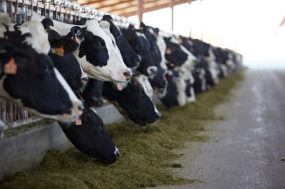1. The next evolution of lameness challenges: Reverse corkscrew claw
Published February 2020
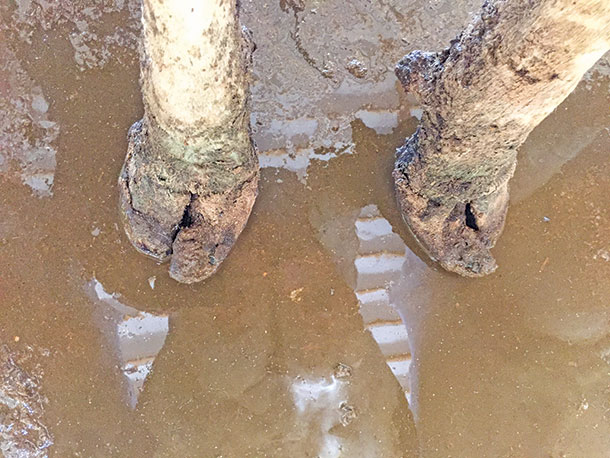
Unexpectedly, a perfect storm of change within our dairy industry created a new hoof health challenge. In the very herds that had lameness under control – where sole ulcers, white-line lesions and digital dermatitis were uncommon findings – we started to see something we hadn’t seen before. A new hoof health challenge known as reverse corkscrew claw syndrome.
What progress have you observed with dairies identifying and changing management practices among heifers to prevent reverse corkscrew claw?
“Many of the dairies facing this problem have made modifications to how they rear heifers. The most common being:
- Switching to housing on bedded packs where possible.
- Reducing the reliance on headlocks for groups of heifers. It is very difficult to move away from this type of feedbunk for breeding-age and prefresh heifers, but for other groups a post-and-rail barrier can be used instead.
- Some of those using deep-bedded sand, especially recycled sand, have switched to bedding with recycled manure solids.
- In new facilities, the team at Comfort Hoof Care have been demo-ing a novel flooring finish called “mini-grooving” for heifer barns.
“With these adaptations, some reduction in the problem has been seen, supporting the hypothesis for its development.”
—Dr. Nigel Cook, Veterinarian, University of Wisconsin – Madison, School of Veterinary Medicine
PHOTO: Intensive confinement practices (such as sand bedding, freestalls, headlocks and overcrowding) introduced to heifers at a young age can result in corkscrew claw deformity characterized by the overgrowth and up-turning of the horn. Photo by Nigel Cook
Read story here: The next evolution of lameness challenges: Reverse corkscrew claw
2. Three dairies offer alternative approaches to biosecurity
Published June 2020

To prevent disease spread, three farms share the biosecurity measures they have in place and the reasons behind them.
Houweling Farms in Coaldale, Alberta, emphasizes disease prevention from birth onward. Newborn calves are vaccinated for scours and respiratory disease and then vaccinated again at 6 weeks and at 8 to 9 months old. Jesse Houweling refers to their vaccination program as “cheap insurance.” To maintain Houweling’s closed herd, sound reproductive strategies are used, and all farm visitors and staff are expected to arrive to the dairy in clean clothes. Additionally, strict cleaning and disinfecting protocols are in place and deliberate barn design choices have been made to ensure biosecurity.
Country Charm Farms Ltd. have spent the past few years trying to eliminate clinical leukosis in their herd. To do this, the farm, located in Abbotsford, British Columbia, has focused on refining the criteria used to select the cows used to supply calves with milk and colostrum. With the help of their vet clinic, Country Charm Farms has developed protocols to maximize biosecurity including the use of a commercial dishwasher to clean bottles, nipples and pails used to collect milk. The protocols also emphasize limiting equipment travel between buildings and the use of several boot wash stations.
After detecting salmonella Dublin in their herd in 2018, Rayner Dairy Research and Teaching Facility in Saskatoon, Saskatchewan, implemented a plan to test their herd every three to five months. Positive cows were put on an accelerated culling program, and calves are moved immediately after birth. The calf barn is now accessible through only one entry point, which is kept locked with only a handful of employees receiving access to the key. All equipment is washed regularly but not with pressure washers, as their spray range is too large. Extra care is taken to clean the skid loader bucket and tires used in the positive cow pen.
What additional measures did you add this year due to COVID-19?
“Some precautions we have taken on our farm is to limit the number of people coming to the yard. We have cancelled any tours that were planned for the upcoming year and are limiting visitors to those who are essential to farm operations.
“We are also asking employees to stay home if they are experiencing any signs of cold or flu and to go in for a COVID-19 test before returning to work.”
—Joel Huizing, dairy producer, Country Charm Farms Ltd.
PHOTO: Participating in the producer panel on biosecurity at the Western Canadian Dairy Seminar in March were, left to right, Joel Huizing, Jay Olyniuk and Jesse Houweling. Photo by Karen Lee.
Read story here: Three dairies offer alternative approaches to biosecurity
3. Lower footbath pH to discourage digital dermatitis
Published February 2020

Digital dermatitis (DD or hairy warts) is the number one cause of lameness among dairy cows; however, there is money to be saved by running the most effective footbath program possible to impact these cows with Type III lesions. Not only is that savings captured by using less product (copper sulphate) in the footbath, but also by focusing the impact on the costliest segment of the herd: the cows with chronic lesions.
This article mentions the importance of promoting healthy hooves among heifer groups. What recommendations do you have for curbing digital dermatitis and subsequent lameness among heifer groups?
“The herds I work with that have the fewest cases of digital dermatitis among the lactating herd do things right to minimize risk factors among heifer groups. However, they do more than simply run a footbath.
“Let’s remember: The primary cause of DD is a breakdown in the immune system. We know that occurs when the animal is stressed, at calving time and when heifers come into their first estrus cycle around 10 to 13 months. Secondly, the bacteria needs compromised skin integrity in order to enter and begin the infection. So if we implement a good nutritional program with added trace minerals, we can enhance the immune response and improve skin integrity.
Then, by providing a clean, dry and well-ventilated environment that is properly stocked, with proper beds and flooring, we can further enhance immune response and improve skin integrity by improved feet and leg hygiene. Trepones need a low-oxygen environment to thrive, so the dirtier the lower portion of the leg, the higher the increase for DD and more likeliness of needing to implement a footbath program in your heifer groups. Lastly, begin weekly pen walks in your heifer groups starting at least at 9 to 10 months and treat immediately any lesions that are observed.”
—Jamie Sullivan, hoof trimmer, Rippleview Hoof Care
Read story here: Lower footbath pH to discourage digital dermatitis
4. Grootendorst Farms to serve as test site for milk tower
Published January 2020
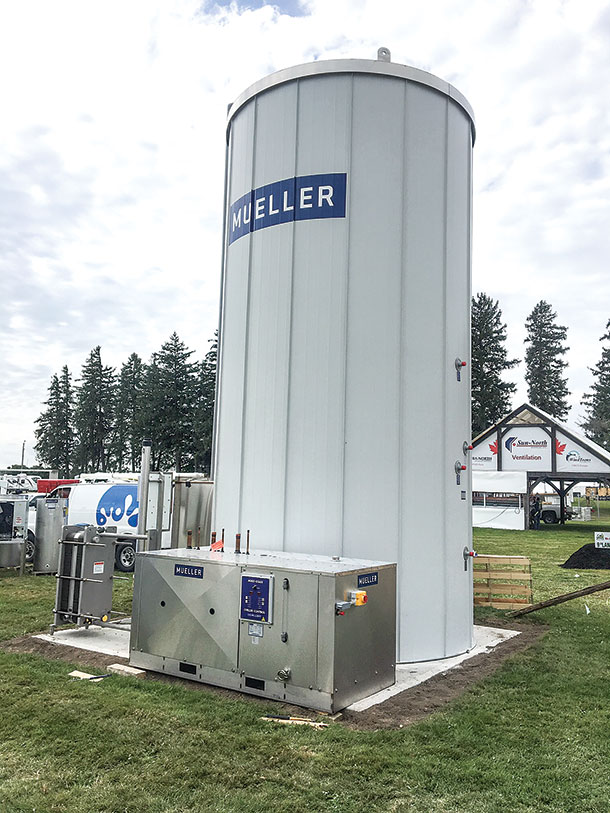
In an effort to reduce the footprint of a milk tank, vertical milk towers have been a logical choice for many processing facilities and farms across the U.S. and Europe. Bypassing the need to expand a farm’s milkhouse in order to accommodate more horizontal milk storage is a chief reason Canadian dairy producers may want to opt for a vertical milk tank with a larger capacity, argues Harlan Martin of Norwell Dairy Systems. However, policy changes to Ontario’s milk pick-up system need to be made before vertical milk tanks can be used more widely in the province.
To adjust their policies, Dairy Farmers of Ontario (DFO) and the Ontario Ministry of Agriculture, Food and Rural Affairs (OMAFRA) have chosen Grootendorst Farms in Breslau, Ontario, as a test site. Due to the shape of the vertical tank, milk quality tests must be modified and therefore tested to ensure results are consistently found to meet milk quality standards. Henk Grootendorst and Martin both noted this will not be an issue as they argue the instant cooling feature implemented by vertical milk tanks is something they estimate may actually improve milk quality. The instant cooling reduces agitation and allows for a more constant temperature in the milk tank to be maintained.
What were some of the initial results of the milk samples collected from the vertical storage?
“The main reason for the test trial was to prove that a milk sample taken from an aseptic port is just as accurate as a sample taken with a traditional vial. I am very pleased to say, month after month, results have confirmed excellent accuracy. I am also pleased to say DFO has received enough satisfactory results to allow them to move the process on to OMAFRA, who is in charge of rewriting the policy, which will need to be revised to allow for a different pick-up procedure from a traditional horizontal milk cooler. I am thankful for the progress that has been made to date, and hopefully it will not be long before full approval has been given.
“I want to say thank you to Grootendorst Farms, as well as DFO and OMAFRA, for their efforts in this project. We’ve all made a great team.”
—Harlan Martin, cooling department manager, Norwell Dairy Systems
PHOTO: Before making its way to Grootendorst Farms for on-farm testing, the milk tower was on display at Canada’s Outdoor Farm Show in September. Photo by Owen Smelski, Canada’s Outdoor Farm Show.
Read story here: Grootendorst Farms to serve as test site for milk tower
5. A magical Christmas: Two baby calves and two proud owners
Published December 2019
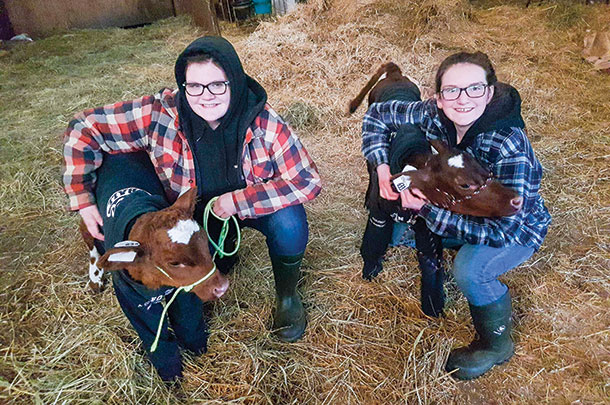
Sisters Ally and Kate Coleman have farming and a love for animals in their blood. Both their parents come from farming backgrounds, and the sisters have grown up on their family’s hobby farm in Hampton, New Brunswick. Their farm is home to pigs, sheep, goats, chickens, ducks, turkeys, Herefords, a draft horse and, most recently, two Milking Shorthorn heifer calves. The newest additions were a great Christmas surprise from Ally and Kate’s parents, who bought the calves from Oceanbrae Farms in Belmont, Prince Edward Island.
Ally and Kate had been saving to buy the calves themselves, with the intention of showing them through their 4-H group, but were elated when their parents presented them with Christmas cards holding pictures and news of their new calves.
In their first year with the calves, Ally and Kate dedicated a lot of time to mounting the steep learning curve they faced entering the show ring. They quickly proved their hard work was not in vain, as both cows found success in the New Brunswick Provincial Show. “We enjoyed every minute of our first year with 4-H dairy projects,” Ally says.
How did you keep up with your dairy project in this unusual year?
“My sister, Ally, and I did not have the intentions to show our ‘Christmas heifers’ this year, so I purchased another intermediate calf born in late December 2019 from Oceanbrae Farms Milking Shorthorns and Jerseys, and Ally was going to show a heifer from the dairy farm she works for.
“Our plans came crashing down when the pandemic hit, as we were both looking forward to this big year in 4-H for the two of us. I won’t lie; I cried when I was notified 4-H was done for the year. But nonetheless, the two of us both spent our summer surrounded by cows at work and made the best of a poor situation. And we entered our ‘Christmas heifers’ and my new heifer in the National Milking Shorthorn show in September.”
—Kate Coleman
PHOTO: Ally and Kate Coleman of Hampton, New Brunswick, each received a Milking Shorthorn calf as a Christmas gift from their parents. Photos provided by the Coleman family.
Read story here: A magical Christmas: Two baby calves and two proud owners
6. What to expect and how to manage corn silage from the 2019 season
Published December 2019
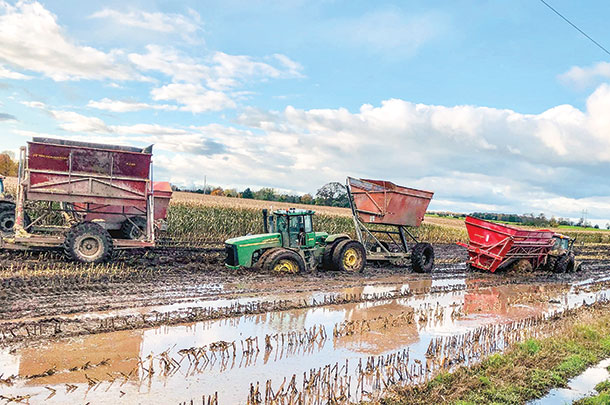
Adverse weather conditions made the 2019 corn silage season a challenging one. Many farms delayed their corn planting, resulting in less grain and low starch (energy) content in their harvested corn silage. Wet conditions made harvest difficult and soil contamination more likely, leading to additional equipment expenses and high ash values in silage. When soil contamination is a concern, effective homolactic forage inoculant should be applied to drive fermentation.
To beat snow and frost, some corn was harvested early, which means fermentation was prolonged and a high acid load was observed along with the potential loss of soluble, highly digestible nutrients due to seepage. Conversely, harvesting after frost or snow, especially if conditions have killed the plant, can lead to ensiling material that is too dry. In this case, particle size and packing density should be checked. Frost-damaged grasses, including corn, should be checked for nitrate levels if fed soon after ensiling.
All these challenges could signal it may be worth it to send representative samples to a credible forage testing facility. Going forward, keep in mind, fully fermented silage with high starch digestibility sees an increase in the amount of soluble, degradable protein and ammonia-N over time.
How can freshly harvested 2020 corn silage help with feeding out the remainder of the 2019 feed?
“This will vary from farm to farm depending on the quality of your silages each year. In general, the 2020 season didn’t have nearly as many problems as 2019, so adding the new silage to the ration could reduce variability and other issues.
“There are some key overall pointers to continue to follow. Although the initial ensiling fermentation (pH drop) is completed quickly (within days), the silage is still in a dynamic state for some time. Keep in mind: Research has shown that the starch digestibility increases over the first eight to 10 months of storage, so this needs to be monitored as you feed the new silage so the ration can be adjusted as necessary. Also, remember to introduce the new silage gradually, at least over 10 to 14 days; the optimal timeframe would be over three to four weeks. Dry matter variability can be another key concern: Test your silages regularly and adjust rations as needed.”
—Renato Schmidt, technical services – forage, Lallemand Animal Nutrition; and Bob Charley, forage products manager, Lallemand Animal Nutrition
PHOTO: Muddy fields were a constant this season. Photo provided by Lallemand Animal Nutrition.
Read story here: What to expect and how to manage corn silage from the 2019 season
7. Stray voltage: What is it and what can be done about it?
Published in February 2020
Dr. Phil Meadows said stray voltage is like a black box, something he might consider when other causes of animal health issues do not seem probable. The Institute of Electrical and Electronics Engineers (IEEE) has defined stray voltage as a voltage resulting from the normal delivery or use of electricity which may be present between two conductive surfaces that can be simultaneously contacted by members of the general public or their animals. “If you are going to deliver electricity, you are going to have stray voltage,” said Muayad Tarabain, team engineer on Hydro One’s farm rapid response team. The Ontario Energy Board (OEB) changed distribution codes in 2009 to include stray voltage testing procedures and a limit of 2 mA with 500 ohms resistance at cow contact point.
Several deficiencies can result in stray voltage, notably defective wire connections, insulation burning out on neutral wire, lack of proper grounding, imbalance of 120-volt loads, equipment problems or any other poor or faulty wiring.
If working with a utility company to troubleshoot, the OEB regulation outlines a process with up to three phases.
- Phase 1 – Determine if there is a stray voltage problem at the property.
- Phase 2 – Measure the contribution. If that contribution is above a 0.5-volt contribution limit on the utility, then they are responsible for fixing their system.
- Phase 3 – Repeat testing to confirm it is below the threshold.
For Hydro One customers, “If you believe you have a stray voltage problem on your farm, you call us – we do all this testing, and it’s at no cost to you,” Tarabain said.
What recent progress has the Ontario Uncontrolled Electricity Working Group (UEWG) made to address stray voltage on farms?
“From our most recent meeting in August, we are working with the Electrical Safety Authority (ESA) in Ontario to publish clearly defined protocols and procedures for when an electrician tests, investigates and mitigates farm stray voltage/current. We want this to help standardize the electrician side of the equation. Consistent protocols/procedures are critical to establish a truly collaborative effort in stray voltage/current investigations between the farmer, electrical contractor, ESA and Hydro One. We think this information needs to come from the licensing body – ESA.”
—Phil Meadows, veterinarian, Mitchell Veterinary Services
Read story here: Stray voltage: What is it and what can be done about it?
8. Making winter ventilation work for you and your cows
Published December 2019
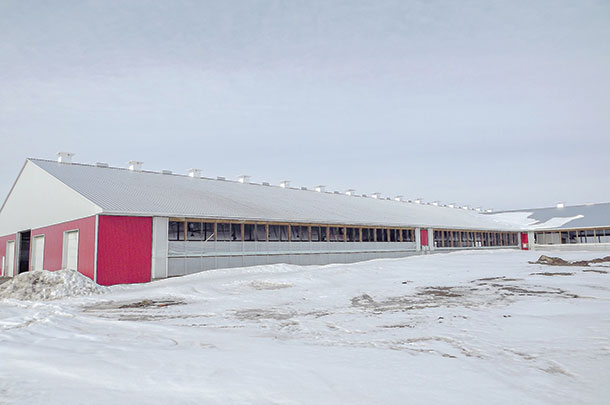
A major challenge of operating a naturally ventilated freestall dairy barn is maintaining a proper environment. To modify cold-weather air exchange in a naturally ventilated barn, simply adjust the interior operating temperature. In general, when you walk into the barn in the morning and it feels cold, it is probably still too warm. Producers should recall, a mature dairy cow will not eat to replace body heat until the air temperature is below -5ºC.
One easy tip to assess your winter ventilation rate: When you walk into the barn, you should smell feed before you smell manure. Smelling manure first is a good indication that ammonia level is too high and thus, humidity levels are too high, and your ventilation rate is too low. If this is the case, lower the temperature on your thermostat.
Where is the best place to position a thermometer to monitor the interior operating temperature of a naturally ventilated barn?
“If you are using a thermometer to monitor interior temperature for manual ventilation adjustments, it is best to position it in an area where there is consistent cattle population. Drop it down to approximately 10 feet from the floor, but be sure to keep it high enough so it is out of reach and will not impede the movement of anything beneath it. For the thermometer itself, a large dial-style works well so that you can easily see it from an aisle.”
—Rick McBay, natural ventilation specialist, Faromor
PHOTO: By opening curtains and lowering the interior temperature of the barn in cold weather, you can increase the ventilation rate. This introduces more fresh air while removing a larger amount of contaminated air from the interior. Photo provided by Faromor (a Canarm Company).
Read story here: Making winter ventilation work for you and your cows
9. Cows’ calcium needs jump 65% in early lactation
Published November 2019
Cows transitioning from dry to lactating status face physiological, metabolic, endocrine and environmental changes.
Plus, in early lactation, cows’ energy demands jump 300%, and calcium requirements climb more than 65%. Cows simply do not have enough appetite to meet these nutrient requirements, according to Dr. Luciano Caixeta, Minnesota College of Veterinary Medicine. This leads to negative balance for both energy and major minerals, especially calcium. Strategically adjusting dietary DCAD, as well as proactive calcium supplementation in early lactation, can be incorporated in protocols to improve health and prevent disease in the first 60 days in milk.
How do requirements and recommendations differ for first-lactation cows versus older cows in the herd when it comes to meeting calcium needs?
“Based on the research results available, we do not have evidence for the use of anionic salts in the prefresh diet nor the use of postpartum oral calcium supplements in animals starting their first lactation. In fact, some of the research results indicate that the use of these strategies can be detrimental to these animals.
Although the exact biological reasons for these differences are not yet established, in a simplistic way we can speculate that these animals might have greater concentrations of circulating calcium because they are still growing and their calcium homeostasis is different, including greater bone metabolism. In addition, first-lactation animals do not produce as much milk as their older counterparts, translating into less calcium being secreted in milk. Together, these two biological differences might explain the distinction in requirements and recommendations when comparing first-lactation animals and older cows.”
— Dr. Luciano Caixeta, assistant professor, University of Minnesota College of Veterinary Medicine
Read story here: Cows’ calcium needs jump 65% in early lactation
10. Why did my DCAD program fail?
Published November 2019
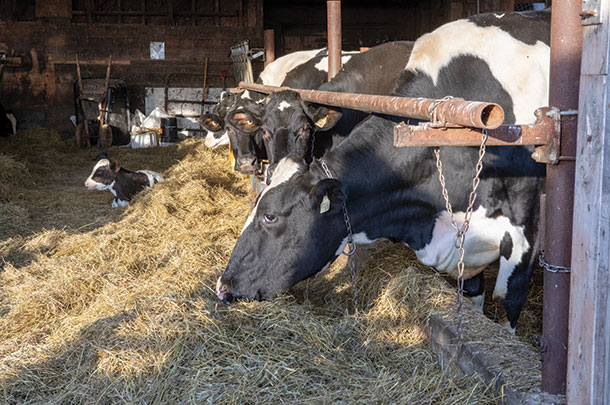
Science has proven that feeding negative DCAD diets to prefresh cows prevents milk fever and helps minimize other common postpartum problems. So why, then, do some producers report that negative DCAD failed on their farm? Two of the most common explanations are failure to acidify cows or insufficient bioavailable magnesium in the diet.
Cows should be metabolically acidified; this means urine pH tests should result in a urine pH of 7.5 in prefresh cows. This is achieved by adding a little extra anionic supplement and possibly by testing minerals and making diet reformulations.
Magnesium is needed to block absorption of some potassium in the rumen and also to facilitate metabolic signaling between endocrine mechanisms and the bones to instruct them to release calcium to improve calcium homeostasis. There is a need for magnesium to be very soluble (bioavailable) as, unlike other divalent minerals, it is absorbed in the rumen. A preference towards magnesium chloride and magnesium sulphate over magnesium oxide should be abided, as the former are more soluble. Other things to watch for include overcrowding of the prefresh pen, inadequate feed mixing and distribution, as well as too much time without food. If problems with negative DCAD diets do arise, start with the basics.
How often should urine pH be checked to ensure the DCAD program is working well?
“‘How often’ infers following a regular schedule, which I don’t believe to be essential for success with negative DCAD nutrition. I recommend checking urine pH mainly based on known dietary changes and observations of cow performance.
“When these changes occur, wait three days and check urine pH.
- Negative DCAD nutrition is implemented for the first time.
- Feeding rate of anionic supplement changes.
- The amount or source of a major ration ingredient is changed (especially forages – field, supplier, cutting date, silo, fertilizer regimen, mineral profile, etc.).
“If you observe the following, check urine pH as soon as possible.
- An uptick in milk fever or disorders associated with subclinical hypocalcemia (displaced abomasum, metritis, retained placenta, cows not transitioning well)
- A sudden drop in feed intake
- Fresh cows with unexplainable transition issues”
—Tim Brown, director of technical support, SoyChlor ![]()
PHOTO: Cattle at the feedbunk. Staff photo.
Read story here: Why did my DCAD program fail?







